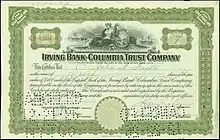Irving Trust
Irving Trust was an American investment bank headquartered in New York City that operated between 1851 and 1988 when it was acquired by Bank of New York. From 1965 the bank was the principal subsidiary of the Irving Bank Corporation.
| Industry | Investment banking |
|---|---|
| Fate | Acquired |
| Successor | Bank of New York |
| Founded | 1851 |
| Defunct | 1988 |
| Headquarters | New York City, United States |
| Products |
Between 1913 and 1931, its headquarters was in the Woolworth Building; after 1931, until it was acquired by Bank of New York, its headquarters was located at One Wall Street, at what is now known as the BNY Mellon Building.
History

The bank had its origins in 1851, when the Irving Bank of the City of New York was founded. Since there was not yet a federal currency, each bank issued its own paper and those institutions with the most appealing names found their certificates more widely accepted. The firm was named after Washington Irving, an author, diplomat, and lawyer who had gained an international reputation as America's first man of letters. His portrait appeared on the bank's notes and contributed to their wide appeal.
In June 1865, it converted from a state bank to a bank chartered under the National Bank Act of 1863, and became the Irving National Bank of New York. In 1907, after a merger, it became the Irving National Exchange Bank of New York, changing its name to the Irving National Bank in 1912.[1] In 1922, it merged with the Columbia Trust Company, a New York State-chartered bank, creating the Irving Bank and Trust Company.[2][1] Later, in 1926, it acquired by merger the American Exchange-Pacific Bank, and changed its name to the American Exchange Irving Trust Company.[1][3] Finally, in 1929, it changed its name to the Irving Trust Company, the name under which it was known until 1989.
As of March 9, 1921, there were four national banks in New York City operating branch offices, also including Catham and Phenix National, the Mechanics and Metals National, the Irving National, and National City Bank.[4] In 1929, Irving was New York's fourth ranked financial institution, and fifth in the United States.[2]
Irving Trust was an official sponsor of the 1980 Winter Olympic Games in Lake Placid, New York.
In 1983, the Irving Trust had 13 branches in New York and was primarily a wholesale bank working with mid- and large-sized corporations and banks. It also had offices around the world, allowing for their claim that the sun never set on the Irving.
Merged into Bank of New York
On October 7, 1988, the Irving Trust board signed an agreement to merge with Bank of New York ending a yearlong battle as Bank of New York engineered a hostile takeover. At the time of the merger the combined banks became the United States' 12th largest bank with asset of $42 billion.[5] During that year Irving had been trying to participate in a friendly merger with Banca Commerciale Italiana.[6]
See also
References
- "1 Wall Street Building" (PDF). New York City Landmarks Preservation Commission. March 13, 2001. pp. 2, 9. Retrieved 2020-05-31.
- "News of Bankers and Banks". Brooklyn Eagle. 1928-05-02. Retrieved 2018-04-30 – via Newspapers.com
 .
. - "Exchange Irving Bank Makes Debut Today; New Consolidation Begins Its Operations With Resources of $600,000,000". The New York Times. 1926-12-13. ISSN 0362-4331. Retrieved 2017-01-14.
- "National City Bank Buys a State Bank; Negotiations About Completed for Purchase of the Commercial Exchange". The New York Times. 1921-03-09. ISSN 0362-4331. Retrieved 2020-05-31.
- Quint, Michael (1988-10-08). "Irving Signs Merger Deal, Ending Fight". The New York Times. ISSN 0362-4331. Retrieved 2020-05-31.
- Glaberson, William (1988-09-27). "Irving Says Suitor Made Rival Flee". The New York Times. ISSN 0362-4331. Retrieved 2020-05-31.